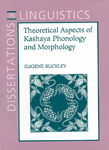

|
|
|
|

Theoretical Aspects of Kashaya Phonology and MorphologyThis study discusses a wide range of phonological and morphological phenomena in Kashaya, a Pomoan language of northern California, and considers their implications for current theories of generative grammar. Issues raised in feature theory include the single-segment status of glottalized and aspirited sonorants, the consonantal nature of glides, the manipulation of laryngeal features, the loss of place features through dissimilation and coda interactions, and vowel harmony. Prosodic analysis supports the licensing. of segments by the mora, a limitedform of final consonant extraprosidicity, and the use of prespecified moraic structure to encode exceptionality. The complex stress system gives evidence that extrametricality is persistent (from early in the lexicon to the postlexical component), and cumulative (present simultaneously on a syllable and foot at the left edge of the stress domain). An overall organization of the lexicon into five levels is posited. Numerous morphological patterns are also discussed, including complex rules of allomorphy, as well as the nature of templates, reduplication, and compounding. is assistant professor of linguistics at the University of Pennsylvania. Contents
List of Verb Suffixes References 12/10/93 ISBN (Paperback): 188152602X (9781881526025)
Subject: Linguistics; Kashaya Language--Phonology; Kashaya Language--Morphology |
Distributed by the
University of Chicago Press |
|
pubs @ csli.stanford.edu
|
CSLI Publications
Stanford University Cordura Hall 210 Panama Street Stanford, CA 94305-4101 (650) 723-1839 |